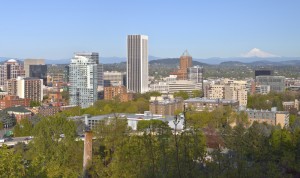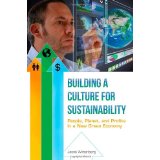No sooner did I finish writing “Green Travel Trends for 2015” than my husband and I took off and traveled for a few days in June.
We visited Portland, Oregon.
That may seem odd, given that we live in the “paradise” of Tampa, Florida. You know – endless sunshine, white sandy beaches, palm trees. Portland has none of that.
But we had heard good things about Portland’s commitment to being a “green city“, so we decided to check it out.
Portland really IS green
Portland is routinely named the “greenest city in America.” In 2015, it’s #1 on Travel and Leisure’s list. What struck me was:
- Lots of trees and parks. There’s no “concrete canyon” feel here. Portland has managed to keep a LOT of trees and parks in the heart of the city.

Portland has lots of trees in the city.
- Great public transit. It’s easy to get around. The transit system – which includes the MAX light rail plus street cars and buses – is clean, cheap and frequent. It’s also growing, with a new line opening in September. When your house has a walk score of 0, being able to walk out the door for a block and (1) stop at a coffee shop or (2) hop on public transit is a miracle.
- Signs of eco-consciousness everywhere. From the many bike riders (who can easily bring their bikes onto public transit), to the solar trash compacters on every block, to the ubiquitous recycling bins, it’s easy to be green in Portland.
That’s all anecdotal, of course, but the statistics and rankings back up my impression.
The Clean Edge guys are my “go-to” researchers for all things happening in “clean tech.” Earlier this month, they released their annual Clean Tech Leadership Index, rating all 50 states and the 50 largest metro areas on their “clean tech” activities.
According to Clean Edge, “OREGON retained its #3 rank for the third straight year, but enjoyed the highest score increase of any top 10 state, up to 72 points from 67 last year when it barely edged out Colorado. Oregon trails only California in the Technology category, with perennial strength in hybrid vehicles, electric vehicles, plug-in hybrids, charging infrastructure, and green buildings. ”
Clean Edge also says, “Portland places #3 for the third time in four years. The Rose City leads all metros in Clean Electricity & Carbon Management, thanks to strong hydroelectric power resources, low carbon emissions from large facilities, and a strong commitment to climate protection and reporting. Portland also ranks #3 in the Green Buildings category.”
Portlanders also know how to have fun
Lest you think Portlanders spend all their free time composting their food scraps, the city offers a great many “attractions,” including:
- Craft Beer – There’s a “craft beer festival” in July, and more breweries than you can shake a stick at.
- Coffee – I visited the biggest Starbucks I have ever seen, and also sipped coffee at Peet’s and Stumptown. There are dozens of other independent coffee houses.
- Restaurants – Thai, Chinese, Morrocan, French, seafood, pizza, and “new American” were just some of the choices.
- Books – Public libraries and Powell’s books make this a book lover’s haven.
- Education – Portland State is minutes from the center of town.
- Parks – There are over 10,000 acres of parks in the city. We spent time in Washington Park, which is 400 acres with 15 miles of trails.
- International Rose Test Garden – you really can “stop and smell the roses” at this 4.5 acre park.
- Waterfront – Portland sits on the Willamette River, and the variety of bridges crossing over to Washington state was astounding.
Portland’s economy is growing
According to Google, Portland’s unemployment rate was 4.4% in April 2015. Like most parts of the country, job growth is stronger than it’s been in years. That strength comes from:
- Silicon Forest – which houses everything from IBM and HP to Microsoft and Intel. It’s an impressive concentration of tech companies employing upwards of 60,000 people.
- Portland green businesses – which tend to be smaller, but are impactful in their own ways. From organic restaurants to environmental consulting firms to engineers and architects, these organizations help bring that “eco-friendly” feel to the city every day.
Keep up the good, green work, Portland!

